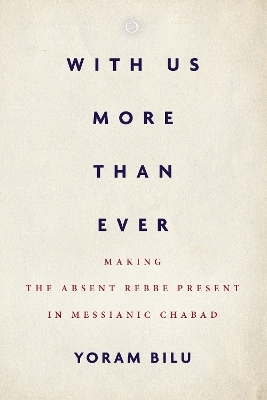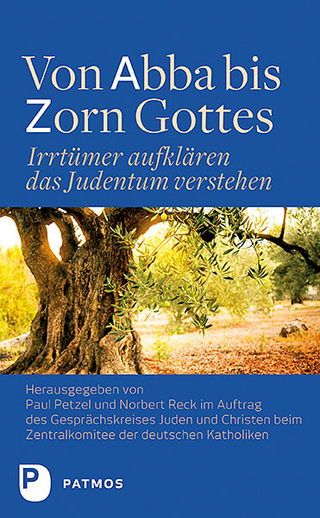
With Us More Than Ever
Stanford University Press (Verlag)
978-1-5036-1241-9 (ISBN)
Yoram Bilu documents a unique religious experience that is distinctly modern. The rallying point of the Meshichistim—that the Rebbe is "with us more than ever"—is sustained through an elaborate system that creates the sense of his constant and pervasive presence in the lives of his followers. The virtual Rebbe that emerges is multiple, visible, accessible, and highly decentralized, the epicenter of a truly messianic movement in the twenty-first century. Combining ethnographic fieldwork and cognitive science with nuanced analysis, Bilu documents the birth and development of a new religious faith, describing the emergence of new spiritual horizons, a process common to various religious movements old and new.
Yoram Bilu is Professor Emeritus of Anthropology and Psychology at the Hebrew University of Jerusalem. He is the author of The Saints' Impresarios: Dreamers, Healers, and Holy Men in Israel's Urban Periphery (2009) and Without Bounds: The Life and Death of Rabbi Ya'aqov Wazana (2000).
Contents and AbstractsIntroduction: Introduction chapter abstractThe messianic surge that swept Chabad in the late 20th century has not subsided following the death in 1994 of Rabbi Menachem Mendel Schneerson, the last president of Chabad and the designated Messiah in the eyes of most Hasidim. Since then, the movement has been able to maintain its popularity and dominance despite the catastrophic loss. Focusing on the Meshichistim ("messianists"), the radical Hasidim who deny the Rebbe's death, the introduction documents the means they employ to fill the void of the Rebbe's "occlusion." The book makes use of a media-studies approach to examine how these means fill the critical role of making the absent Rebbe present. The data are based on interviews with Meshichists, participant observations in their gatherings, and meticulous perusal of messianic publications, primarily periodicals. The discussion includes a description of the charged interrelationships that developed between the author and the Hasidim during fieldwork.
1Chabad and the Messianic Idea chapter abstractThe chapter follows the vicissitudes of the messianic idea in Chabad from the movement's inception to the stormy years of the seventh and last leader, Menachem Mendel Schneerson. As shaped by its founder, Rabbi Schneur Zalman, Chabad was less prone to messianic tension than were other Hasidic sects. The fifth admor, Rabbi Shalom Dov Ber, resorted to messianic discourse in the late 19th century in order to battle the lure of secular ideologies such as communism and Zionism. His son and successor, Rabbi Yosef Yitzchak, viewed the horrors of the Holocaust as messianic tribulations. But it was Rabbi Menachem Mendel Schneerson who generated acute messianic turbulence by advancing to his Hasidim the notion of imminent redemption. The Rebbe's messianic vision, kept alive by the Hasidim after his departure, forms the background for the means and practices that constitute the messianic ecology in contemporary Chabad.
2Meshichist Sociology chapter abstractThe chapter presents the major sociological features of the Meshichists. The Meshichists are more prevalent in the movement's periphery. Of Chabad's two main centers, they are more strongly represented in Israel than in the U.S. and more among the younger Hasidim in either place. –. In accord with the enthusiasm and high commitment typically displayed by religious immigrants and converts anywhere, new Chabadniks, coming from secular or other religious backgrounds, are overrepresented among the Meshichists. As a result of their outreach activities, Chabadniks anywhere tend to be more socially and politically involved in the wider society than are other ultraorthodox Jews, and the Meshichists all the more so. One indication of their assimilation into Israeli society is their use of military language in articulating their ideas and activities.
3Writing to the Rebbe: The Holy Letters Oracle chapter abstractThis chapter discusses the bibliomantic device the Hasidim developed to continue the dialogue with the absent Rebbe. The technique is based on inserting a petition randomly into one of the thirty-two volumes of the Rebbe's collected letters. Even though these letters were written to other people at other times, the petitioners maintain that the answers they receive are germane to their own pleas. The veridicality of the answers is redoubled when they play out in the real world. Following the miraculous stories associated with the Holy Letters Oracle, the chapter discusses its growing popularity and accounts for its success. The popularity and success of the technique seem to confirm the assertion of the Meshichistim that despite his occlusion, the invisible Rebbe is more accessible than ever.
4Sensing the Rebbe: Traces and Practices of Embodiment chapter abstractHow do the Hasidim perceive the absent Rebbe as close and involved? This chapter discusses a broad range of signs or "traces" of the Rebbe, such as the Rebbe's abode, his armchair, the dollar bills he distributed for charity, and the water from his ritual bath, which the Hasidim are adamant to keep intact and, where possible, to replicate. Primarily in Chabad headquarters in Crown Heights, but also in Chabad Houses all over the world and in the Meshichists' homes, these artifacts serve as focal points for ritual practices that involve the Rebbe as an active participant. The traces and practices interweave to produce a "messianic ecology" that actualizes the Rebbe among his followers. In the religion-media paradigm, these traces and practices are conductors of his presence.
5Seeing the Rebbe I: Chabad's Visual Culture chapter abstractChapter Five is devoted to Chabad's visual culture as evidenced by the widespread use of still photographs and film footage of the Rebbe, which bolster his visual salience to an unprecedented extent in Judaism. The elaborate cult that has been developing around the Rebbe's images borders on iconophilia. The pictures serve as focal points for this wide-ranging visual cult. They are used as amulets, thwarting threats and curing maladies; as magnets drawing and attaching passersby to the Rebbe; and as icons triggering the elaborate ritual encounters between the Rebbe and his devotees. The chapter discusses the Rebbe's iconic picture, in which he is shown waving his hand in encouragement, and how it has taken on a life on its own.
6Seeing the Rebbe II: Dream and Waking Apparitions chapter abstractChapter Six maps the Rebbe's apparitions in dreams and then moves to reports of apparitions in normal waking states. The author proposes a psychocultural model to account for these apparitions, deeming them evidence of contextual accomplishment rather than psychopathological deficit. Two distinct clusters of apparition experiences emerge, one associated with ritual and the other with mundane settings. In comparison to Christian visionary experiences, the Rebbe's apparitions are hyper-realistic, literal reinforcements of the claim that the Rebbe is alive. While this claim is audacious ontologically, it limits the epistemological horizons of the messianic imaginary and detracts from its significance as a "taste" of the redemption.
7Schneersoncentrism: The Rebbe Steers the World chapter abstractFor the Meshichistim, the invisible Rebbe is the center of the world. Chapter Seven conveys this conviction through the notion of "Schneersoncentrism," the belief that the Rebbe steers the world and navigates its events. It discusses two broad domains where the Rebbe's imprint on the world is indelible, according to the Hasidim: natural disasters, which the Rebbe is able to stop, and manmade political upheavals, which the Rebbe can rectify. According to his followers, the Rebbe's fingerprints are evident in key historical moments such as the collapse of the Soviet Union, the Exodus of its Jews, and the American victory in the second Gulf War.
8The Apotheosis of the Rebbe chapter abstractChapter Eight deals with the sensitive issue of the Rebbe's deification, a corollary of his centrality in the universe. While the Chabad mainstream argues that attempts to deify the Rebbe are limited to the movement's lunatic fringes, it shows that activists in the Meshichist camp are not hostile to these attempts and, under special circumstances, are even willing to give them a voice. The mystical doctrine of the tzadik in Hasidism, which views him as part of the divine system of emanations, and the messianic shturem in Chabad today help attenuate the deep-seated resistance in Judaism to glorifying a human being.
9"To Make Many More Menachem Mendels": Creation and Procreation in Messianic Chabad chapter abstractChapter Nine illustrates the divine role accorded to the Rebbe in the fantasy lives of some of his followers by zooming in on his alleged role in one domain of human misery: infertility and birth problems. Drawing on a small sample of dreaming and waking apparitions, the chapter shows how the childless Rebbe "reproduces" himself by providing childless couples with children in his image. In these reports the Rebbe appears as a creator no less than as a progenitor.
10Holy Place and Holy Time in Meshichist Chabad chapter abstractChapter Ten discusses the spatial and temporal dimensions of holiness in the messianic religion. For the Meshichists, who ordinarily refrain from frequenting the Rebbe's sanctuary in Old Montefiori Cemetery in Queens, the most sacred site is the Rebbe's abode on 770 Eastern Parkway in Crown Heights, Brooklyn, dubbed "770." Viewed as the house of the Messiah and a wing of the future third Temple, 770 is the Meshichist hub, where the life routine with the Rebbe is kept intact. Replicas of 770 have been built in scores of places across the globe. The Meshichist emphasize two dates in Chabad's ritual calendar: Yod-Aleph (11) Nissan, the Rebbe's birthday, and Gimel Tammuz, the date of the Rabbi's disappearance, euphemistically called the Day of Redemption.
11The Omnipresence of Absence: Messianism in the Technological Age chapter abstractChapter Eleven discusses the present-absent virtual Rebbe, maintained in part by the magic of technology. In analyzing the properties of his virtuality, it is suggested that the Rebbe is multiple (reproduced), close and palpable, visible, accessible, and highly decentralized. The fact that the virtual Rebbe can be directly accessed and equally shared by all Hasidim poses a potential threat to Chabad's hierarchical structure and cohesion.
12Meshichists, Christians, Sabbateans, and Popular Culture Heroes chapter abstractThe dynamic common to past and present messianic movements is the focus of Chapter Twelve. It considers the struggles of Chabad's messianism in light of the Christian and Sabbatean precedents. It also poses a speculative comparison between the cult of the Rebbe that emerges from Chabad's visual culture and the adoration of charismatic entertainment and political celebrities in global popular culture.
13From Tzadik to Messiah: Comparing Chabad and Bratslav chapter abstractChapter Twelve proposes a systematic comparison of Chabad and Bratslav Hasidism. Both of these Hasidic movements lack the defining feature of a classic Hasidic sect, a serving tzadik-admor, yet they are enjoying unprecedented success. Can the flourishing of these two movements be attributed to the messianic expectations they both nurture? In support of this supposition, the chapter seeks to decipher the enigma of the growing popularity of these two "anomalous" Hasidic sects by dwelling on their propensity for border-crossing in various domains.
Conclusion chapter abstractThe messianic surge that swept Chabad in the late 20th century has created the opportunity for studying the religious imagination at large, and as a subject in its own right. Messianic movements expand the boundaries of proper religious conduct and bring to the fore modes of action and experience the religious establishment shuns as extreme or subversive. The media and the practices that Meshichists employ to make the absent Rebbe present were born in this fertile, enabling ecology. More daring and pronounced than ordinary institutionalized religious beliefs and rites, they differ only in degree. The conclusion discusses the unprecedented extent to which the Rebbe-cum-Messiah is glorified, the boundless energy his elevated status generates in his followers, and their capacity to cope with the disappointment of his occlusion by sustaining a virtual Rebbe that is palpable and close.
| Erscheinungsdatum | 09.06.2020 |
|---|---|
| Reihe/Serie | Spiritual Phenomena |
| Zusatzinfo | 30 photographs |
| Verlagsort | Palo Alto |
| Sprache | englisch |
| Maße | 152 x 229 mm |
| Themenwelt | Geisteswissenschaften ► Religion / Theologie ► Judentum |
| Sozialwissenschaften ► Ethnologie | |
| Sozialwissenschaften ► Soziologie | |
| ISBN-10 | 1-5036-1241-4 / 1503612414 |
| ISBN-13 | 978-1-5036-1241-9 / 9781503612419 |
| Zustand | Neuware |
| Informationen gemäß Produktsicherheitsverordnung (GPSR) | |
| Haben Sie eine Frage zum Produkt? |
aus dem Bereich


